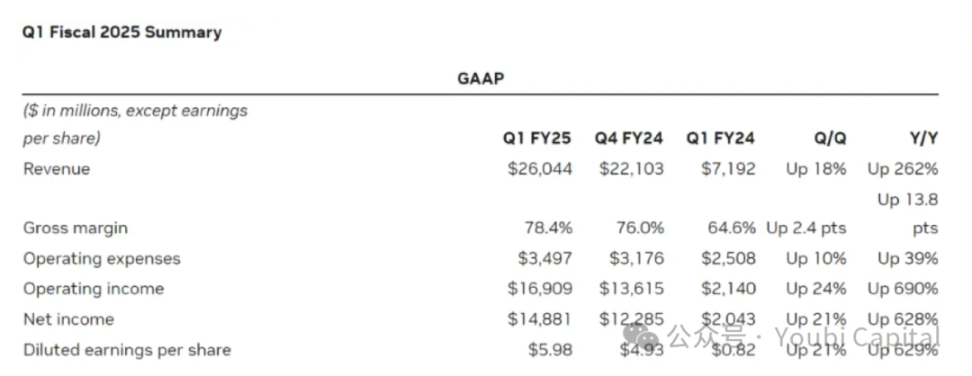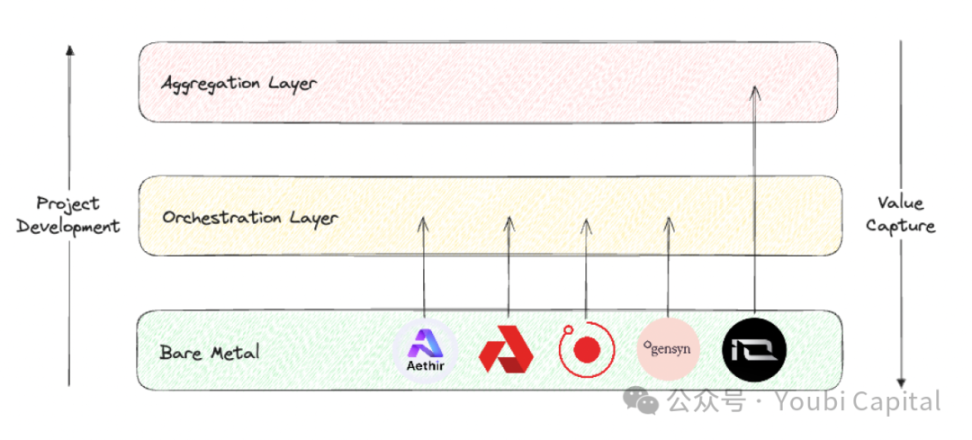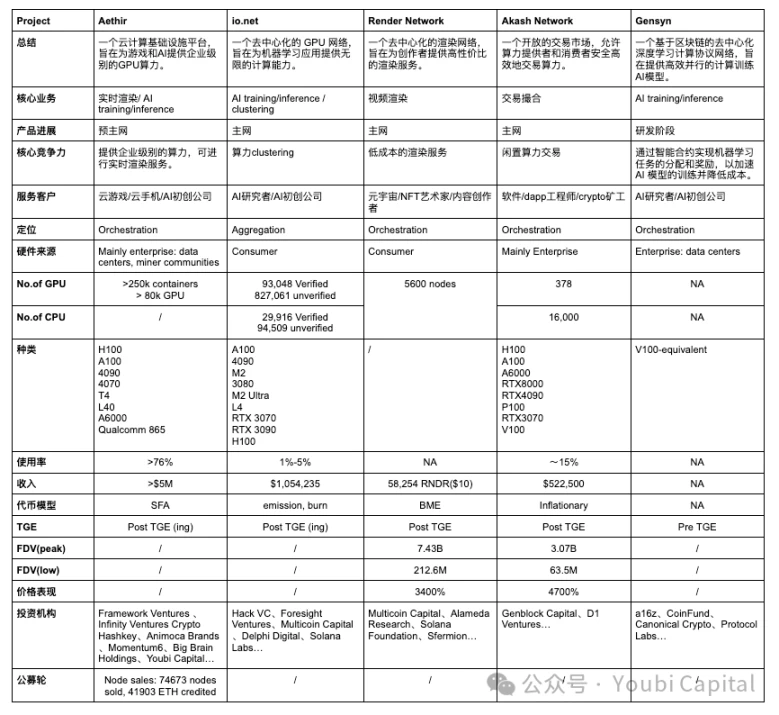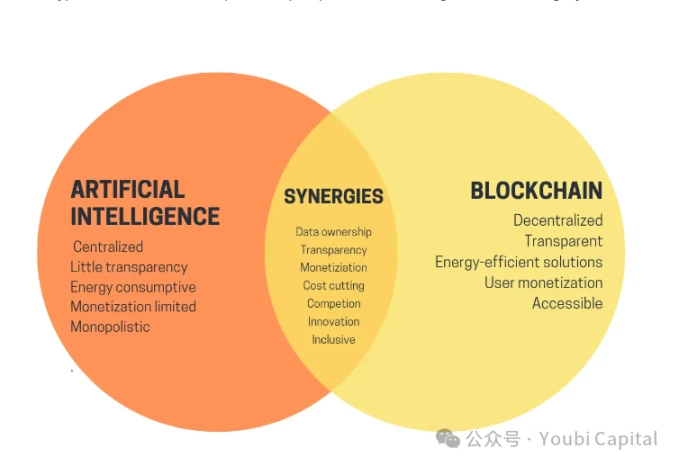原作者:Jane Doe、陳莉
原始來源: 優幣資本
1 人工智慧與加密貨幣的交叉點
5月23日,晶片巨頭英偉達發布了2025財年第一季財報。其中,數據中心收入比去年增加了4,27%,達到驚人的US$226億。 英偉達能夠憑藉一己之力拯救美國股市的財務表現背後,是全球科技公司為了在AI賽道上競爭而爆發的算力需求。越是頂尖科技公司在AI賽道上雄心勃勃的佈局,其對算力的需求就越是指數級增長。根據TrendForces預測,2024年需求 美國四大雲端服務商:微軟、Google、AWS和Meta的高階AI伺服器預計將分別佔全球需求量的20.2%、16.6%、16%和10.8%,總計超過60% 。
圖片來源:https://investor.nvidia.com/financial-info/financial-reports/default.aspx
多年來,晶片短缺一直是年度流行語。一方面,大型語言模型(LLM)的訓練和推理需要大量的算力支持;並且隨著模型的迭代,算力成本和需求呈指數級增長。另一方面,像Meta這樣的大公司會採購大量晶片,全球算力資源向這些科技巨頭傾斜,使得小型企業越來越難以獲得所需的算力資源。 小企業面臨的困難不僅來自需求激增導致的晶片供應不足,也來自供給的結構性矛盾。 目前供給端仍有大量GPU閒置。例如,部分資料中心存在大量閒置算力(利用率僅12%-18%),大量算力資源也因利潤減少而閒置在加密挖礦上。 雖然這些算力並不都適合AI訓練等專業應用場景,但消費級硬體在AI推理、雲端遊戲渲染、雲端手機等其他領域仍可發揮巨大作用。整合利用這部分算力資源的機會是巨大的。
將我們的注意力從人工智慧轉向加密貨幣,加密市場在沉寂了三年之後,又一個多頭市場終於到來了。比特幣價格屢創新高,各種迷因幣紛紛湧現。 雖然這些年來人工智慧和加密貨幣一直流行為流行語,但人工智慧和區塊鏈作為兩項重要技術就像兩條平行線,尚未找到交點。 今年年初,Vitalik 發表了一篇題為《加密+人工智慧應用的前景與挑戰》的文章,討論了人工智慧與加密結合的未來場景。 Vitalik在文章中提到了許多願景,包括利用區塊鏈、MPC等加密技術去中心化AI的訓練和推理,可以打開機器學習的黑盒子,讓AI模型更加去信任等等。長的路要走。 但Vitalik提到的用例之一——用加密貨幣經濟誘因來賦能AI,也是一個可以在短時間內實現的重要方向。去中心化算力網路是現階段最適合AI+加密的場景之一。
2 去中心化運算網絡
目前,去中心化算力網路領域已經有許多專案在開發。這些項目的底層邏輯都是相似的,可以歸納為: 利用代幣激勵算力持有者參與網路提供算力服務,而這些分散的算力資源可以聚合成一定規模的去中心化算力網路。這不僅可以提高閒置算力的利用率,還可以以更低的成本滿足客戶的算力需求,實現買賣雙方的雙贏。
為了讓讀者能夠在短時間內對這個賽道有一個整體的了解,本文將從微觀和宏觀兩個角度對具體項目以及整個賽道進行解構,旨在為讀者提供一個分析的視角來理解其核心。作者將介紹並分析五個項目: Aethir、io.net、渲染網路、Akash 網路、Gensyn ,並對專案狀況進行總結和評估並追蹤發展。
從分析框架來看,如果我們專注於一個具體的去中心化計算網絡,我們可以將其分解為四個核心組成部分:
-
硬體網路 :整合分散的運算資源,透過分佈在全球的節點實現運算資源的共享和負載平衡。它是去中心化計算網路的基礎層。
-
雙邊市場 :透過合理的定價和發現機制,將算力提供者與需求者配對起來,提供安全的交易平台,確保供需雙方的交易透明、公平、可信。
-
共識機制 :用於保證網路中的節點正確運作並完成其工作。共識機制主要用於兩個層面的監控:1)監控節點是否在線,是否處於活躍狀態,隨時可以接受任務; 2)節點工作證明:節點收到任務後有效正確地完成任務,且運算能力沒有被用於其他目的並佔用進程和執行緒。
-
代幣激勵 :通證模型用於激勵更多參與者提供/使用服務,並使用通證捕捉這種網路效應,實現社區利益共享。
如果我們鳥瞰整個去中心化算力賽道,Blockworks Research 的研究報告提供了一個很好的分析架構。我們可以將這條賽道的項目位置分成三個不同的層次。
-
裸金屬層 :去中心化計算堆疊的基礎層。它的主要任務是收集原始運算資源並使它們可用於 API 呼叫。
-
編排層 :去中心化計算堆疊的中間層。其主要任務是協調和抽象。負責算力的調度、擴充、運轉、負載平衡和容錯。其主要功能是抽象化底層硬體管理的複雜性,為最終用戶提供更高級的使用者介面,以服務特定的客戶群。
-
聚合層 :它構成了去中心化計算堆疊的頂層。其主要任務是整合。它負責提供統一的接口,以便用戶可以在一個地方實現多個計算任務,例如AI訓練、渲染、zkML等,相當於多個去中心化計算服務的編排和分發層。
圖片來源:優幣資本
基於以上兩個分析框架,我們將對五個入選項目進行橫向比較,並從四個層面進行評估: 核心業務、市場定位、硬體設施及財務表現 .
2.1 核心業務
從底層邏輯來看,去中心化算力網路高度同質化,也就是利用代幣激勵閒置算力持有者提供算力服務。基於這個底層邏輯,我們可以從三個面向來理解專案核心業務的差異:
-
閒置算力來源:
-
市面上閒置算力的來源主要有兩個:1)資料中心、礦工等公司手中的閒置算力; 2)散戶手中的閒置算力。資料中心的運算能力通常是專業級硬件,而散戶通常購買消費級晶片。
-
Aethir、Akash Network 和 Gensyn 的算力主要來自企業。 向企業收集算力的好處是:1)企業和資料中心通常擁有更高品質的硬體和專業的維護團隊,算力資源的效能和可靠性更高; 2)企業和資料中心的算力資源往往更加同質化,集中管理和監控使得資源調度和維護更有效率。但相應的,這種方式對專案方的要求也更高,專案方需要與控制算力的企業有商業聯繫。同時,可擴展性和去中心化也會受到一定程度的影響。
-
Render Network和io.net主要鼓勵散戶提供閒置算力。 向散戶收集算力的好處是:1)散戶閒置算力的顯性成本低,可以提供更經濟的算力資源; 2)網路更具可擴展性和去中心化性,增強了系統的彈性和穩健性。缺點是零售資源分佈廣泛且不統一,管理調度複雜,增加維運難度。依賴零售算力形成初始網路效應也比較困難(啟動難度更高)。最後,零售設備可能存在更多的安全風險,這會帶來資料外洩和算力濫用的風險。
-
算力消費者
-
從算力消費者角度來看,Aethir、io.net、Gensyn的目標客戶主要是企業。 對於B端客戶來說,AI和遊戲即時渲染需要高效能運算需求。此類工作負載對算力資源需求極高,通常需要高階GPU或專業級硬體。另外,B端客戶對算力資源的穩定性、可靠性要求較高,必須提供高品質的服務等級協議,以確保專案的正常運作並提供及時的技術支援。同時,B端客戶的遷移成本非常高。如果去中心化網路沒有成熟的SDK讓專案方能夠快速部署(例如Akash Network需要使用者自己基於遠端連接埠進行開發),客戶將很難遷移。如果不是極為顯著的價格優勢,顧客遷移的意願會很低。
-
Render Network和Akash Network主要為散戶提供算力服務。 為C端用戶提供服務,專案需設計簡單易用的介面與工具,為消費者提供良好的消費體驗。消費者對價格也非常敏感,因此項目需要提供有競爭力的價格。
-
硬體類型
-
常見的運算硬體資源包括CPU、FPGA、GPU、ASIC和SoC。這些硬體在設計目標、效能特徵和應用領域方面存在顯著差異。綜上所述,CPU更擅長通用運算任務,FPGA的優點是高度平行處理和可程式化,GPU在平行運算方面表現良好,ASIC在特定任務上效率最高,而SoC則集多種功能於一身,適合高度整合的應用。選擇哪種硬體取決於具體應用的需求、效能要求和成本考量。 我們討論的去中心化算力項目大多是收集GPU算力,這是由專案業務類型和GPU的特性決定的。因為GPU在AI訓練、平行運算、多媒體渲染等方面具有獨特的優勢。
-
雖然這些項目大多涉及GPU集成,但不同的應用對硬體規格的要求不同,因此這些硬體具有異質的最佳化核心和參數。 這些參數包括並行/串行依賴性、記憶體、延遲等。例如,渲染工作負載實際上更適合消費級 GPU,而不是更強大的資料中心 GPU,因為渲染對光線追蹤的要求很高,而 4090 等消費級晶片具有增強型 RT 核心,專門針對光線進行了優化追蹤任務。 AI訓練和推理需要專業級GPU。因此,Render Network可以向散戶收集RTX 3090、4090等消費級GPU,而IO.NET則需要H 100、A 100等更專業級的GPU來滿足AI新創公司的需求。
2.2 市場定位
從專案定位來看,裸機層、編排層和聚合層要解決的核心問題、最佳化重點和價值捕捉能力不同。
-
裸機層著重於實體資源的收集和利用,編排層著重於算力的調度和最佳化,根據客戶群的需求優化實體硬體的設計。聚合層是通用的,專注於不同資源的整合和抽象。從價值鏈的角度來看,每個項目都應該從裸金屬層開始,努力向上攀登。
-
從價值捕獲的角度來看,價值捕獲能力從裸機層、編排層到聚合層逐層增強。 聚合層能夠捕捉最多的價值,因為聚合平台可以獲得最大的網路效應,直接觸及最多的用戶,相當於去中心化網路的流量入口,從而在整個運算資源管理中佔據最高的價值捕獲位置堆。
-
相應地,聚合平台的搭建是最困難的。本專案需要全面解決技術複雜性、異質資源管理、系統可靠性和可擴展性、網路效應實現、安全和隱私保護、維運管理複雜等諸多問題。這些挑戰不利於專案的冷啟動,取決於賽道的發展和時機。 在編排層成熟並佔據一定市場份額之前,建立聚合層是不切實際的。
-
現在, Aethir、Render Network、Akash Network 和 Gensyn 都屬於 Orchestration 層,它們旨在為特定目標和客戶群體提供服務。 Aethirs目前的主要業務是雲端遊戲的即時渲染,並為B端客戶提供一定的開發部署環境和工具; Render Networks主要業務是視訊渲染,Akash Networks使命是提供類似淘寶的交易平台,Gensyn則深度涉足AI訓練領域。 io.net定位為聚合層,但io目前實現的功能距離聚合層的完整功能還有一段距離。雖然Render Network和Filecoin的硬體已經集齊,但硬體資源的抽象化和整合還沒有完成。
2.3 硬體設施
-
目前,並非所有項目都發布了詳細的網路數據。相對而言,io.net explorer的UI最好,可以看到GPU/CPU的數量、類型、價格、分佈、網路使用情況、節點收入等參數。然而,4月底,io.net前端遭到攻擊。由於io沒有對PUT/POST介面進行Auth,駭客篡改了前端資料。這也為其他項目的隱私和網路資料的可靠性敲響了警鐘。
-
從GPU的數量和型號來看,io.net作為聚合層,應該是收集了最多的硬體。 Aethir緊跟在後,其他專案的硬體情況就沒那麼透明了。從GPU型號上我們可以看到io既有A 100等專業級GPU,也有4090等消費級GPU,種類繁多,很符合io.net聚合的定位。 io可以根據特定任務需求選擇最適合的GPU。但不同型號、品牌的GPU可能需要不同的驅動和配置,軟體也需要複雜的最佳化,增加了管理和維護的複雜度。目前io中各種任務的分配主要是根據使用者的選擇。
-
Aethir發布了自己的礦機。 5月,在高通支援下開發的Aethir Edge正式上線。它將打破遠離使用者的單一集中式GPU叢集部署模式,將算力部署到邊緣。 Aethir Edge將結合H100的叢集運算能力來服務AI場景。它可以部署經過訓練的模型,並以最佳成本為使用者提供推理計算服務。此方案更貼近用戶,服務更快捷,性價比更高。
-
從供需角度來看,以 Akash Network 為例,其統計顯示 CPU 總數約為 16k,GPU 數量為 378 個。 其中,只有專業級GPU H 100的出租率比較高,其他型號大多處於閒置狀態。其他網路面臨的情況與 Akash 大致相同。整體對網路的需求不高。除了A 100、H 100等熱門晶片外,其他算力大多閒置。
-
從價格優勢來看,除了雲端運算市場的巨頭外,與其他傳統服務商相比,成本優勢並不突出。
2.4 財務表現
-
無論通證模型如何設計,健康的通證經濟需要滿足以下基本條件: 1)用戶對網路的需求需求反映在幣價中,這意味著通證能夠捕獲價值; 2)所有參與者,無論是開發者、節點或用戶,都需要長期、公平的激勵; 3)確保去中心化治理,避免內部人過度持股; 4)合理的通膨通貨緊縮機制和代幣發行週期,避免幣價大幅波動影響網路的穩健性和永續性。
-
如果我們一般將代幣模型分為BME(銷毀和鑄幣均衡)和SFA(存取權益),這兩種模型的代幣通貨緊縮壓力的來源是不同的:BME模型在用戶購買服務後銷毀代幣,因此系統的通貨緊縮壓力是由需求決定的。 SFA要求服務商/節點質押代幣以獲得提供服務的資格,因此通貨緊縮壓力是由供應帶來的。 BME的優點是更適合非標準化商品。但如果網路需求不足,可能面臨持續通膨的壓力。各個項目的代幣模型在細節上有所不同,但總體來說, Aethir 更喜歡 SFA,而 io.net、Render Network 和 Akash Network 更喜歡 BME,Gensyn 仍然未知。
-
從收益角度來看,網路的需求將直接體現在網路整體收益中(礦工的收益這裡不討論,因為礦工除了完成任務的獎勵之外,還獲得專案的補貼)。從公開數據來看,io.net 的價值最高。雖然Aethir的營收尚未公佈,但根據公開訊息,他們已經宣布與多家B端客戶簽訂了訂單。
-
從幣價來看,只有Render Network和Akash Network進行了ICO。 Aethir和io.net最近也發幣了,其價格表現還需觀察,這裡不再詳細討論。 Gensyns 的計劃仍不清楚。從這兩個已發幣的項目以及同賽道已發幣但不屬於本文範圍的項目來看, 總的來說,去中心化算力網絡具有非常可觀的性價比,這在一定程度上體現了巨大的市場潛力和社區的高度期望。
2.5 總結
-
去中心化運算網路賽道整體發展迅速,許多專案已經可以依靠產品來服務客戶並產生一定的收入。賽道已經脫離了純粹的敘事,進入了可以提供初步服務的發展階段。
-
需求弱是去中心化運算網路面臨的通病,長期的客戶需求沒有得到很好的驗證和挖掘。不過需求端並沒有對幣價造成太大影響,幾個已經發幣的項目都表現良好。
-
人工智慧是去中心化運算網路的主要敘述,但它並不是唯一的業務。算力除了用於AI訓練和推理之外,還可以用於雲端遊戲、雲端手機服務等的即時渲染。
-
算力網路的硬體異質性較高,算力網路的品質和規模有待進一步提升。
-
對於C端用戶來說,成本優勢並不是很明顯。對於B端用戶來說,除了節省成本外,還需要考慮服務的穩定性、可靠性、技術支援、合規性和法律支援等,而Web3專案在這些方面普遍做得不好。
3 結束語
人工智慧的爆發性成長對算力產生了巨大的需求。自 2012 年以來,人工智慧訓練任務中使用的運算能力呈指數級增長,目前每 3.5 個月翻倍(摩爾定律每 18 個月翻一番)。自2012年以來,運算能力的需求成長了超過30萬倍,遠遠超過摩爾定律的12倍成長。據預測,未來五年GPU市場預計將以32%的複合年增長率成長至超過$2000億。 AMD的預估更高,該公司預計GPU晶片市場到2027年將達到$4000億。
圖片來源:https://www.stateof.ai/
因為人工智慧和其他運算密集型工作負載(例如 AR/VR 渲染)的爆炸性增長暴露了傳統雲端運算和領先運算市場的結構性低效率。理論上,去中心化的運算網路可以利用分散式的閒置運算資源,提供更靈活、低成本、更有效率的解決方案,從而滿足市場對運算資源的龐大需求。因此,加密貨幣與人工智慧的結合具有巨大的市場潛力,但也面臨來自傳統企業的激烈競爭、較高的進入障礙和複雜的市場環境。 總的來說,縱觀所有加密賽道,去中心化運算網路是加密領域最有前途、能夠滿足實際需求的垂直領域之一。
圖片來源 :https://vitalik.eth.limo/general/2024/01/30/cryptoai.html
未來是光明的,但道路是曲折的。實現上述願景,我們還需要解決許多問題和挑戰。總之: 現階段,如果只提供傳統的雲端服務,專案的利潤空間很小。從需求端來看,大型企業普遍自建算力,純C端開發者多選擇雲端服務。真正使用去中心化算力網路資源的中小企業是否會有穩定的需求,還需要進一步的探索與驗證。另一方面,人工智慧是一個廣闊的市場,有著非常高的上限和想像空間。對於更廣大的市場,去中心化算力服務商未來也需要向模型/AI服務轉型,探索更多加密+AI的使用場景,擴大專案所能創造的價值。但目前,進一步在AI領域發展仍有許多問題與挑戰:
-
價格優勢並不突出 :從先前的數據比較可以看出,去中心化運算網路的成本優勢並沒有反映出來。可能的原因是,對於H100、A100等需求量較大的專業晶片,市場機制決定了這部分硬體的價格不會便宜。此外,去中心化網路雖然可以收集閒置的運算資源,但去中心化帶來的規模經濟缺失、網路和頻寬成本高昂、管理和運維極其複雜等都會進一步增加運算成本。
-
AI訓練的特殊性 :現階段AI去中心化訓練存在巨大的技術瓶頸。這個瓶頸可以直觀地體現在GPU工作流程中。在大型語言模型的訓練中,GPU首先接收預處理後的資料批次,並進行前向傳播和反向傳播計算以產生梯度。接下來,每個GPU聚合梯度並更新模型參數以確保所有GPU同步。這個過程將重複進行,直到所有批次的訓練完成或達到預定的輪數。這個過程涉及大量的資料傳輸和同步。採用什麼樣的平行和同步策略,如何優化網路頻寬和延遲,降低通訊成本等,目前還沒有很好的答案。現階段,使用去中心化算力網路來訓練AI不太現實。
-
資料安全和隱私 :在大型語言模型的訓練過程中,資料處理和傳輸的各個環節,如資料分佈、模型訓練、參數和梯度聚合等,都可能影響資料安全和隱私。此外,資料隱私比模型隱私更重要。如果資料隱私問題解決不了,就不可能真正在需求面做規模化。
從最現實的角度來看,去中心化運算網路需要兼顧當前的需求發現和未來的市場空間。找到合適的產品定位和目標客戶群,例如先針對非AI或Web3原生項目,從相對邊緣的需求開始,建立早期的使用者基礎。同時,不斷探索人工智慧與加密貨幣結合的各類場景,探索技術前沿,實現服務轉型升級。
參考
https://vitalik.eth.limo/general/2024/01/30/cryptoai.html
https://foresightnews.pro/article/detail/34368
https://research.web3 caff.com/zh/archives/17351?ref=1554
本文源自網路:誕生於邊緣:去中心化算力網路如何賦能加密與人工智慧?
相關:Solana 代幣成長持續創歷史新高,解釋了成長引擎 Pump.fun
原創| Odaily 星球日報 作者 |南至4月份,市場經歷了大幅回調,但Solana市場卻愈發火熱。 5月4日,新發行的SPL代幣繼續創下14,648的歷史新高。新發行的代幣中有一半以上來自 Pump.fun。 Odaily星球日報將解讀平台功能、數據及此現象。關於 Pump.fun Pump.fun 於 2024 年 2 月上線,是 Meme 代幣的一鍵發行平台。 2月推出時,追蹤使用的用戶並不多。到3月中旬,用戶數量和使用量開始飆升。運行流程創建代幣:發行者只需輸入代幣的名稱、描述和圖像並支付...













